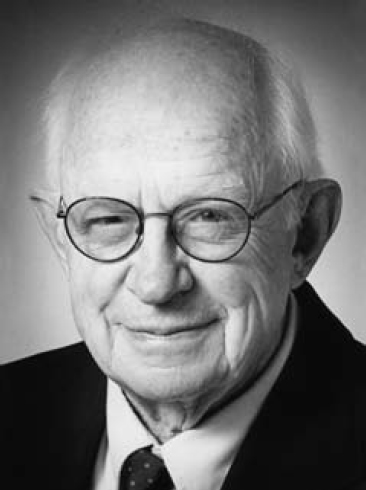
1922–2010
Elected in 1976
“For contributions in nuclear power utilization and in nuclear engineering education.”
BY DONALD R. OLANDER
THOMAS H. PIGFORD, professor emeritus and founding chair of the Department of Nuclear Engineering at the University of California, Berkeley, and an influential voice in nuclear policy, died at the age of 87 on February 28, 2010. Pigford’s five-decade career in nuclear engineering spanned reactor design, nuclear safety, fuel cycles, and radioactive waste management.
At UC Berkeley, Pigford led a research program to develop the theoretical means for predicting the long-term behavior of radioactive and chemical waste in underground disposal sites. Results of this research have been used in the design of geologic repositories in the United States and abroad. He championed nuclear power but not at the expense of appropriate safeguards for health and the environment. He was respected among scientists and environmentalists alike for his technical expertise and objectivity.
He was appointed to numerous advisory commissions on nuclear reactor safety, including the Expert Consultant Group to Evaluate the Chernobyl Accident and the President’s Commission on the Accident at Three Mile Island (TMI). “It was Tom’s wisdom, judgment and practical experience that, in my opinion, led to the TMI Commission’s recommendations being so well thought-out,” said Vice Admiral Eugene Wilkinson, commander of the first nuclear submarine and first president of the Institute of Nuclear Power Operations. These recommendations have stood the test of time and have served as a catalyst for significant change. Even representatives of strongly antinuclear organizations admired and respected Pigford’s straightforward, honest approach: “He was very strongly pro-nuclear and, because of that, he wanted it to be done right,” said Daniel Hirsch, a lecturer of nuclear policy at UC Santa Cruz and president of the Committee to Bridge the Gap, a nonprofit organization critical of nuclear development. “He knew a nuclear program couldn’t be viable if safety problems were ignored. I admired him beyond measure.”
Pigford was one of the first to develop nuclear chemical engineering as an important subdiscipline of nuclear technology at a time when President Eisenhower was pushing strongly for nuclear power. The book that Pigford coauthored with Manson Benedict, called Nuclear Chemical Engineering (McGraw-Hill, 1957), is considered the seminal text in this field. The entire fuel cycle, from extraction of uranium ore, isotope separation, fabrication of fuel rods, reprocessing of spent fuel, to storage of radioactive waste is addressed in this book.
Pigford was born on April 21, 1922, in Meridian, Mississippi. He received his bachelor’s degree (magna cum laude) in chemical engineering from the Georgia Institute of Technology in 1943. He continued his graduate studies in chemical engineering at the Massachusetts Institute of Technology (MIT), where he earned his Sc.D. degree in 1952.
After an interlude in the U.S. Navy and while still completing his doctorate, Pigford became associate professor of nuclear and chemical engineering in 1955. In addition to teaching
and research, his career at MIT included a two-year stint as director of the MIT Graduate School of Engineering Practice in Oak Ridge, Tennessee. In 1952 he and Manson Benedict inaugurated MIT’s graduate program in nuclear engineering. From 1957 to1959 he was a founding staff member at General Atomics, a nuclear technology research and development firm based in La Jolla, California.
In 1959, Pigford joined the UC Berkeley faculty as a full professor and the first permanent chair of the newly established nuclear engineering department. He served three nonconsecutive terms as department chair between 1959 and 1988. In 1966, Pigford spearheaded the construction of a 1-megawatt research reactor in Etcheverry Hall. Two decades later the reactor’s role in research began to wane and the decision was made to shut it down, a process Pigford oversaw. The reactor was finally decommissioned in 1991, the same year Pigford retired and became professor of the graduate school.
Among the numerous honors Pigford received throughout his career were the Robert E. Wilson Award, given by the American Institute of Chemical Engineers for outstanding chemical-engineering contributions and achievements in the nuclear industry; election to the Georgia Institute of Technology Engineering Hall of Fame; and the Berkeley Citation. He was cofounder and charter member of the American Nuclear Society, to which he was elected a fellow in 1971. Pigford was elected to the National Academy of Engineering in 1976.
He was an avid tennis player and an enthusiastic and competitive sailor. As skilled with his hands as he was with his mind, he also was an accomplished woodworker, a dedicated gardener, and an amateur musician who played French horn, recorder, and oboe at various points in his life.
Pigford’s first wife, Catherine Kennedy Pigford, died in 1992. He is survived by his second wife, the former Elizabeth Hood Weekes (of Oakland, California); his daughters from his first marriage, Cynthia Pigford Naylor (of Durham, California) and Julie Pigford Earnest (of Portland, Oregon); and his stepdaughters from his second marriage, Janvrin Demler (of Dedham, Massachusetts) and Laura Weekes (of
Los Angeles). Also surviving him are five grandchildren and a great-grandson. Tom’s brother Robert, who predeceased him, also was an NAE member.
Elizabeth Pigford wrote:
“He had a brilliant mind, a compassionate heart, an exuberant curiosity about absolutely everything, a puckish and playful wit, a strong and spirited will, an irrepressible sense of humor, a rock solid sense of honor, a unique creative energy, a keen insight into others, a delight in nature, sports, books and music, a quiet inexhaustible courage. He was a loving spouse and a loyal friend.”






